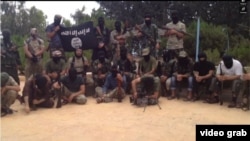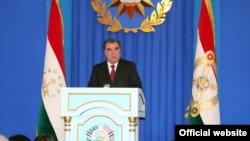
The Islamic State (IS) militant group poses a challenge in areas far from Syria and Iraq. Dozens of governments around the world are pondering the IS threat not only to the Middle East but also to their own countries. This is especially true in countries with a Muslim majority, such as the five Central Asian states.
The International Crisis Group (ICG) recently released a report, Syria Calling: Radicalisation In Central Asia, that looked at why some people from Central Asia are going to join the IS militants, who these people are, and why they represent a threat to their homelands.
RFE/RL's Turkmen Service, known locally as Azatlyk, organized a roundtable discussion on the topic moderated by Azatlyk director Muhammad Tahir. The panelists were Deirdre Tynan, the ICG Central Asia project director; Noah Bonsey, the ICG senior analyst on Syria; Joanna Paraszczuk, who writes about IS for RFE/RL in the Under The Black Flag blog; and myself.
Why they go is an interesting question in the case of Central Asians. The vast majority of Central Asians are Sunni Muslims but past that there is little that unites them with the land of Al-Sham. Why do Central Asians, mainly Turkic and Persian peoples whose recent history includes nearly 75 years as part of the atheist Soviet Union, decide to leave their relatively peaceful native lands and fight on the side of an essentially Arab group widely denounced as barbaric and depraved?
According to the ICG report, during the last three years some 2,000 to 4,000 citizens of Kazakhstan, Kyrgyzstan, Tajikistan, Turkmenistan, and Uzbekistan have gone to Syria to join IS.
It was suggested the root causes for their decision to leave were the repressive nature of the Central Asian governments and limited prospects for the future. As Tynan put it, "What does Central Asia have to offer a young person who wants to express themselves, who wants to have economic opportunities in their own region without having to move to Russia to get a job?"
Still, while hundreds go, millions stay.
Central Asians have been going to join Islamic militant groups in Afghanistan and Pakistan since the late 1990s. But unlike Afghanistan and Pakistan, where by far most of the Central Asians are men, young women are going to Syria and there have been instances of whole families going as well.
Tynan pointed out that for some it's about more than escaping the socioeconomic situation back home. "It is people who have genuine religious ideals and they believe they are part of a big project that is not just about taking up arms or being a combatant in the classic sense, and that appeals very much to women and families, and to a very diverse cross-section of society in Central Asia," Tynan said.
That was one of the key conclusions in the ICG report: that people were motivated to join IS for religious rather than financial reasons.
Ethnically, most of those going to Syria are Uzbeks, according to the ICG report, but it was pointed out that Uzbeks are the largest ethnic group in Central Asia and, for example, also make up the largest group of migrant laborers in Russia.
Paraszczuk added that social media had played a big role in who is attracted to go to Syria. "The Kazakhs, for example, and the Uzbek groups" in Syria have a social-media presence. Paraszczuk said online discussions are "on a very colloquial, one-on-one level [and] it's very easy to access someone who's in Syria and it's very easy to ask them questions about what life is like there." The Turkmen, in contrast, do not seem to be as active and that is almost certainly due to the Turkmen government's rigid control over media and Internet access.
And Bonsey pointed out, IS is able to spin its message to potential Central Asian recruits. He said IS emphasizes the civilian casualties inflicted by government forces in Syria and Iraq. "They [Central Asians] want to join what they view as a legitimate resistance against these oppressive regimes," Bonsey said, and added, "people sympathizing with jihadis of course view jihadi groups, ISIS first and foremost, as the natural, potential means of joining that fight."
Bonsey explained that getting that message across is vital for IS. "The fact that ISIS is able to continue to generate the kind of positive image among potential recruits in Central Asia…helps them to fill all kinds of manpower gaps or what would otherwise be manpower gaps, whether we're speaking about combatants or people in supporting roles."
The ICG report said most of the Central Asians going to Syria would probably be killed there. But there will be some who will try to go home, such people are the concern of governments around the world and Central Asia is no exception.
Tynan said the security services in Central Asia "are simply not equipped to track or to monitor or to counteract the radicalization that is going on." And the disparity of how these governments approach the problem of these repatriates from conflict zones seems bound to create problems specifically for one country.
"We've heard that Kazakhstan and Uzbekistan will certainly operate what was described to us as a zero-tolerance approach to returning fighters, but that actually is bad news for Kyrgyzstan because Kyrgyzstan is a more open society and people who intend to return to Central Asia will more likely go back to Kyrgyzstan because they can reenter the country and will not be surveilled in a way that they would be in Uzbekistan or Kazakhstan," Tynan noted.
Another problem for all five Central Asian states is identifying those returning from the conflict zone. Fighting-age males will be easy enough to spot, but as Paraszczuk noted women and children could be among those returning one day and could also represent a security threat after what they've been exposed to in Syria.
You can listen to the entire roundtable discussion here:
-- Bruce Pannier







